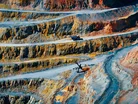Barrick’s Kibali gold mine rolls out a new 10-year plan

Barrick Gold, the Canadian mining company that produces gold and copper at sixteen locations in thirteen countries, has announced that it is rolling out a 10-year plan at its Kibali mine in the Democratic Republic of Congo.
As Africa's largest gold mine and Tier One asset, Kibali has grown over the last ten years from its inception into a much-expanded operation and expects to maintain that status at least for the next decade. Tier One mines can produce 500,000 oz. or more of gold for at least ten years at a cost below the industry average.
In its press release, Barrick reported that Kibali increased production in the past quarter as part of its planned ramp-up to meet its annual guidance. Meanwhile, successful exploration is expected to replenish reserves depleted by mining again.
The mine draws most of its power from its three hydropower stations on the Kibali River. A planned 16MW solar farm, designed to back up the hydropower during the Democratic Republic of Congo's (DRC's) dry season, is expected to increase the renewable power contribution to the mine's energy grid from 79% to 88%, with Kibali running entirely on renewables during the wet season.
Paving the way for biodiversity and community development
Mark Bristow, president and chief executive of Barrick, said creating a world-class mine and a thriving local economy in one of the DRC's remotest and least developed regions represented a triumph for the successful partnership between the company, the government, and its host communities. He further commented, "Our stakeholders in the DRC have benefited enormously from Kibali, which over the past ten years has contributed US$4.6bn to the country in the form of dividends, royalties, and taxes. In line with our local procurement policy, Kibali gives preference to Congolese suppliers and contractors, who have received US$2.5bn from the mine to date."
In the 13 years since the acquisition of the property, which became Kibali, the company has paid salaries amounting to US$621m. It has invested about US$196m in infrastructure development and community support.
Another way in which Barrick has shown its commitment to the DRC is by helping preserve the Garamba National Park by reintroducing 16 white rhinos to the National Park in the northeast of the DRC, where the species was last seen in 2006. Barrick has provided more than US$2.5m for tracking collars, fuel for observation planes, rescue and rehabilitation programs, and improvements to critical infrastructure such as roads and bridges.



